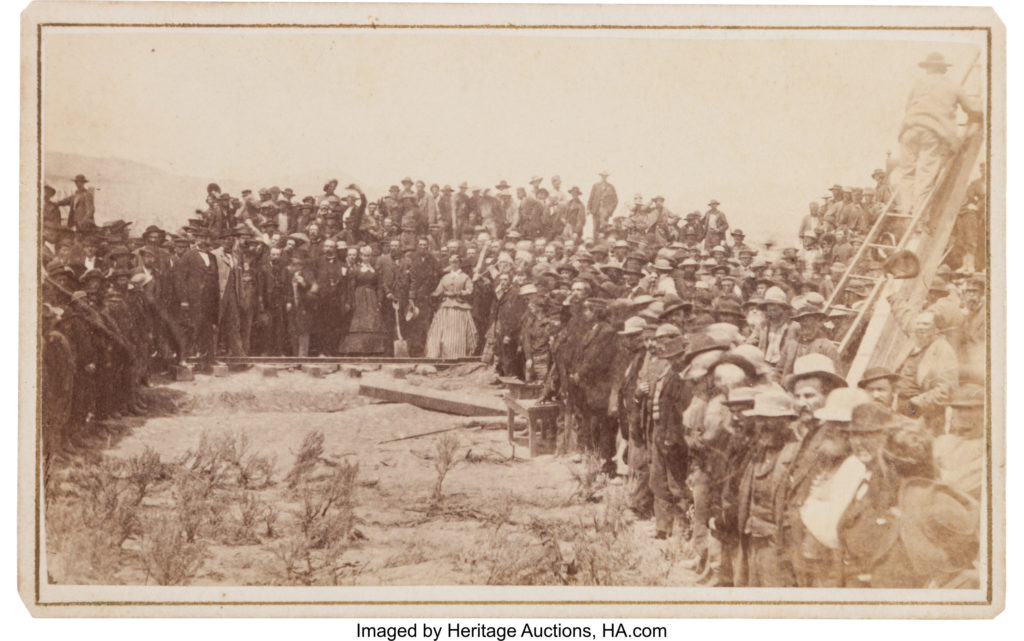
By Jim O’Neal
Undoubtedly, the greatest achievement in America during the 19th century was the completion of the Transcontinental Railroad in 1869. Virtually everyone knows at least part of the story when the two railroad lines were joined on May 10 and Central Pacific President Leland Stanford drove the 14-ounce “Last Spike” (later the Golden Spike) at Promontory Point in Utah. But fewer are aware the spike was dated May 8 – bad weather caused a two-day delay – or that he whiffed and missed it. Still, the telegraph operator sent the message “Done” to both East and West Coasts in the first mass media event in history.
This was a long-overdue project that had been mired in slavery politics when Congress was unable to reach agreement on how to maintain the status quo on new states ready to join the Union. The exception was the Republic of Texas, which was added as the 28th state on Dec. 29, 1845, the same day the annexation took place, bypassing the traditional territorial phase. It also included two unique provisions: Up to four additional states could be created within the territory and Texas did not have to cede its public lands to the federal government.
However, the growth of railroads in the existing states had been astonishing. Starting from a modest base of 762 miles in 1834, 10 years later it had grown to 4,311 track miles and by Jan. 1, 1864, to a staggering 33,860! In the 1850s, an average of 2,160 miles of new track were added every year, more than the rest of the world combined. Horace Greeley, founder of the New-York Tribune, put it in perspective after an overland trip from NYC to SFO. He wrote that a railroad to the Pacific would add more growth and wealth to the nation than acquiring a dozen Cubas!
Eventually, the discovery of gold in California and the rapid growth in population combined to create a booming economy that helped balance West-to-East traffic and improve two-way profitability. It was during the frenetic times after the railroad was completed that two men walked into the Bank of California in downtown San Francisco in early 1872 carrying a canvas bag they wanted to store in the bank’s vault. They claimed to be prospectors and the cashier demanded to inspect the contents.
He found hundreds of diamonds, emeralds, rubies and sapphires of unimaginable value. Bank President William Ralston, who had made a personal fortune mining Nevada’s Comstock Lode, was able to get them to identify themselves and get their version of this remarkable story. Thus began the saga of Philip Arnold and John Slack, who purported to be miners from Kentucky who had stumbled onto a hill where precious stones were protruding and abundantly scattered around the site. Ralston quickly formed a magnificently named company, the San Francisco and New York Mining and Commercial Company, and persuaded blue-chip investors to chip in $80,000 each for a total capitalization of $2 million.
When word got out, it created a diamond frenzy and even the great jeweler Charles Tiffany jumped in after the two men agreed to show two blindfolded diamond experts the site and they brought back another bag filled with diamonds and verified the area was saturated with precious stones. The two nervous prospectors agreed to sell their share for $300,000 each and a percentage of future profits. Naturally, it was an extremely clever scam that involved them “salting” the mine and concocting the elaborate hoax details.
Then, on Sept. 4, 1872, in the middle of the presidential election, headlines in The New York Sun were screaming THE KING OF FRAUDS… COLOSSAL BRIBERY… HOW SOME MEN GET FORTUNES. But they were talking about the biggest scandal of the 19th century: the Crédit Mobilier scam, which involved railroads, bogus companies, worthless bonds and bribes using stocks involving congressmen and even U.S. Vice President Schuyler Colfax.
It was that kind of year.
 Intelligent Collector blogger JIM O’NEAL is an avid collector and history buff. He is president and CEO of Frito-Lay International [retired] and earlier served as chair and CEO of PepsiCo Restaurants International [KFC Pizza Hut and Taco Bell].
Intelligent Collector blogger JIM O’NEAL is an avid collector and history buff. He is president and CEO of Frito-Lay International [retired] and earlier served as chair and CEO of PepsiCo Restaurants International [KFC Pizza Hut and Taco Bell].
